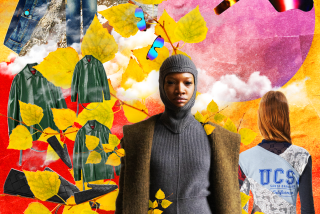Definitive : Hurray for the Beret
The beret is back on top again.
The snug-fitting, loosely shaped classic cap is the perfect complement to menswear-inspired women’s wear and the long, lean silhouettes of fall.
Hair this season--which is influenced by the ‘40s, but with a softer edge for the ‘90s--is highlighted best by a beret because it covers only the top of the head, exposing one’s bob or flip.
Berets can be squished, flopped and molded to accentuate the wearer’s best facial features.
But berets are not just for women. The cap’s flexibility makes it bearable to men and children.
Crowning glories: The classic style, in black and navy blue, is mostly made of felt or wool and shrunk to shape and size during the dyeing process. The tam is a multicolored variation usually made of wool, and the sailor’s hat comes in many styles, including one with a stiff brim accented by braid.
To many people, the beret is considered as French as Chanel, champagne and crepes suzette. But the cap’s origins date to ancient times.
During the Bronze Age, the Cretans chose the beret for its simple design and usually made it of felt, knitted or woolen cloth.
In pre-modern Greece and Rome, the beret was worn much tighter on the head, had a semi-stiff headband and the look of a mushroom cap or an open umbrella.
In the 16th Century, the velvet biretta, a square hat with three or four vertical proportions, was fashionable. By the early 1800s, women wore berets with upturned brims trimmed with feathers, ribbons and other accouterments, mostly with evening wear.
The relaxed, fuller shape of the classic beret didn’t become en vogue until the 1920s, when it was adopted as part of the uniform for the military and the French working class.
At this year’s Emmy Awards, model Cindy Crawford sported a beret. Was hers a nod to past? Or hat’s off to the revival? Cindy isn’t saying.
More to Read
The complete guide to home viewing
Get Screen Gab for everything about the TV shows and streaming movies everyone’s talking about.
You may occasionally receive promotional content from the Los Angeles Times.






